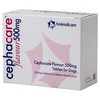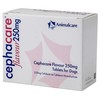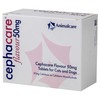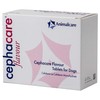Cephacare
Cephacare Flavoured Tablets are for the treatment of infections of the respiratory tract, urogenital tract, the skin and localised infections in soft tissue caused by bacteria sensitive to cefalexin. It can also be used for the treatment of infections in the gastrointestinal tract of cats.
Cephacare Tablets are beef flavoured, beige coloured tablets with a break mark on each side for easy and accurate dosing.
Cephacare 500mg Flavoured Tablets for Cats and Dogs
£0.70Cephacare 500mg Flavoured Tablets are indicated for the treatment of infections of the respiratory tract, urogenital tract, the skin, and localised infections in soft tissue caused by...[More info]
Cephacare 250mg Flavoured Tablets for Cats and Dogs
£0.55Cephacare 250mg Flavoured Tablets are indicated for the treatment of infections of the respiratory tract, urogenital tract, the skin, and localised infections in soft tissue caused by...[More info]
Cephacare 50mg Flavoured Tablets for Cats and Dogs
£0.30Cephacare 50mg Flavoured Tablets are indicated for the treatment of infections of the respiratory tract, urogenital tract, the skin, and localised infections in soft tissue caused by...[More info]
Cephacare 1000mg Flavoured Tablets for Cats and Dogs
£1.36Cephacare 1000mg Flavoured Tablets are indicated for the treatment of infections of the respiratory tract, urogenital tract, the skin, and localised infections in soft tissue caused by...[More info]
Contraindications
Do not use in cases of known hypersensitivity to the active substance, to other cephalosporins, to other substances of the β-lactam group or to any of the excipients.
Do not use in rabbits, gerbils, guinea pigs and hamsters.
Special warnings for each target species
None
Special precautions for use
Special precautions for use in animals
Use of the product should be based on susceptibility testing and take into account official and local antimicrobial policies.
Use of the product deviating from the instructions given in the SPC may increase the prevalence of bacteria resistant to cefalexin and may decrease the effectiveness of treatment with penicillins, due to the potential for cross resistance.
In the case of an allergic reaction, treatment should be withdrawn.
As with other antibiotics which are excreted mainly by the kidneys, unnecessary accumulation may occur in the body when renal function is impaired. In cases of known renal insufficiency the dose should be reduced, antimicrobials known to be nephrotoxic should not be administered concurrently and the product should be used only according to a risk/benefit assessment by the responsible veterinarian.
Special precautions to be taken by the person administering the veterinary medicinal product to animals
Penicillins and cephalosporins may cause hypersensitivity (allergy) following injection, inhalation, ingestion or skin contact. Hypersensitivity to penicillin may lead to cross-reactions to cephalosporin and vice versa. Allergic reactions to these substances may occasionally be serious. Do not handle this product if you know you are sensitised or if you have been advised not to be in contact with such substances.
Handle this product with great care to avoid exposure, taking all recommended precautions. If you develop symptoms following exposure such as skin rash, you should seek medical advice and show the doctor this warning. Swelling of the face, lips or eyes or difficulty breathing are more serious symptoms and require urgent medical attention.
In case of accidental ingestion, seek medical advice immediately and show the package leaflet or the label to the physician.
Wash hands after use.
Adverse reactions (frequency and seriousness)
Transient episodes of soft faeces and vomiting have been observed in cats when given products containing cefalexin. Treatment should be discontinued if vomiting and diarrhoea develop.
Vomiting has been observed occasionally in dogs when given products containing cefalexin.
Use during pregnancy, lactation or lay
The safety of the product has not been demonstrated in studies in pregnant or lactating dogs and cats. Use only in accordance with a risk/benefit assessment by the responsible veterinarian.
Interaction with other medicinal products and other forms of interaction
The bactericidal activity of cephalosporins is reduced by concomitant administration of bacteriostatic acting compounds (macrolides, sulphonamides and tetracyclines).
Nephrotoxicity can be increased when 1st generation cephalosporins are combined with polypeptide antibiotics, aminoglycosides and some diuretics (furosemide).
Concomitant use with such active substances should be avoided.
Amounts to be administered and administration route
For oral administration.
Dogs:
A dose of 15 mg/kg twice daily is recommended, to be doubled where appropriate.
Treatment for five days is recommended. Any increase in dose or duration of use should be according to a risk/benefit assessment by the prescribing veterinarian (e.g. in cases of chronic pyoderma).
Cats:
A dose of 15 mg/kg twice daily for 5 days is recommended.
Tablets may be added to food if necessary.
To avoid underdosing, the bodyweight should be accurately determined.
Overdose (symptoms, emergency procedures, antidotes), if necessary
The administration of cefalexin has been shown to produce no serious side-effects at many times the recommended dose rate.
Withdrawal period(s)
Not applicable.



